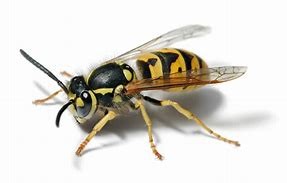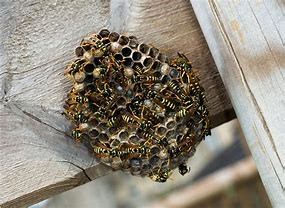Wasps…What you Need to Know
A wasp (scientifically known as Vespula vulgaris) is any insect of the scientific order Hymenoptera and that is not a bee or an ant. There are several species of wasps – two main types of wasps are:
- Social wasps like the common wasp, paper wasp, yellow jacket and hornet, and,
- Solitary wasps including the Potter wasp, Cicada killer wasp and the mud wasp.

Visual Characteristics
Wasps visually vary tremendously depending on species. The eyes of a wasp are kidney-shaped. Wasps have two pairs of wings, the hind wings smaller than the forewings. Their wings are folded longitudinally at rest and the mouth parts are adapted for chewing and licking. Wasps can easily be distinguished from bees because of their pointed body and waist.
They range in colors from black to metallic green and blue and can range in size from almost microscopic to an inch or more in length.
Wasps are critically important in nature by maintaining an ecological balance. Almost every pest insect species has a wasp species that is predator or parasite upon it. Interestingly, wasps make a distinct buzzing noise.
Nests
Wasps are social insects forming colonies inside nests specially constructed in soil, barks, roof spaces and in tree and wall cavities. Wasps are frequently found in domestic housing. Wasps are social insects with a queen, who is much larger than the workers and who start a new nest each year. Nests are constructed of wasp paper made by chewing wood and other plant debris mixed with saliva.

Unlike honeybees, wasps have no wax-producing gland. They manufacture a paper-like material from wood pulp. Wood fibers are gathered from weathered wood, softened by chewing and mixed with saliva. The paper is then used to make combs with cells for nurturing juvenile larvae.
The fertilized queen wasp emerges from hibernation around mid-April and searches for a suitable site for a nest. The queen rears the first progeny of worker wasps by herself and upon hatching these workers will continue building of the nest. The queen, the only wasp able to lay eggs, will remain in the nest laying more eggs for further generation of wasps.
The more workers there are, the quicker the nest will grow. By late summer, the normal wasp nest will contain from 3,000 to 5,000 insects and be up to 12 inches in width. With cooler weather, the workers and males may become tired and aggressive towards any interference. The cold winter weather kills off all the workers and males, with only the queen surviving.
Wasp Types and Behavior
Some wasps are predatory, while others are parasitic. Predatory wasps kill and consume other insects as well as other animals which they often feed to their larvae.
Parasitic wasps typically lay their eggs in the bodies of living creatures like caterpillars or spiders. The larvae feed on the still-living host. Wasps can assist in the management of other pests, particularly in agriculture as biological control agents. Many wasps also feed on nectar from flowers and therefore function as pollinators.
Some wasps are aggressive species and can sting when threatened. Unlike honeybees, wasps often are capable of stinging multiple times.
In contrast, solitary wasps live alone and therefore do not have a colony. They do lay eggs, but their eggs are left alone to hatch.
How Do You Get Wasps?
Eaves, soffits, and gutters on home exteriors are popular wasp nesting spots. Flowers and plant life attract them, as do outdoor eating areas with crumbs or sticky soda spills that are not sanitized. Garbage cans that are not properly covered and regularly emptied also attract wasps seeking sources of food. Properties with abundant insects and spiders provide ample prey for both developing and mature wasps. Contrary to popular, but incorrect information, nests left behind by wasp populations that die during the cold weather months are generally not reused by subsequent generations.
How Serious Are Wasps?
Wasps near the home can ruin outdoor activities and make yardwork difficult. While they rarely go out of their way to sting, wasps may become hostile if threatened or disturbed. Their stings are painful but typically nonthreatening to those without allergies to the wasp’s venom.
What Should You Do If You Discover a Wasps’ Nest?
It is highly recommended that destruction of wasp nest is not undertaken by the homeowner or the untrained. Call Millette Pest Control today if you discover a wasp nest. We offer free inspections and will explain our plan for removal as we inspect your property.
